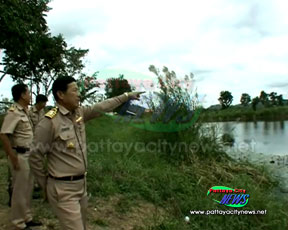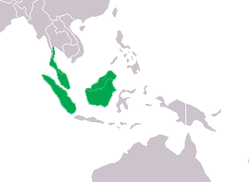First Thai Tomistoma Since 1970
Posted by: Loren Coleman on November 23rd, 2007
Some unique crocs have been seen in Thailand. But as opposed to merely “out-of-place” or escaped reptiles, it might signal a recovery of a locally “extinct” species.

Loosely using the term “gavial,” some form of a gavial or gharial is the source of this attention. Either it is the true gharial, Gavialis gangeticus, identified as such by the local Thai media, or the false gharial Tomistoma schlegelii, the preferred choice, I read after I first saw this news item, of cryptozoologist Chad Arment. Since I respect Arment’s opinion on this, as he knows his herps rather well, his insights over the local reporter’s seems the correct call here.

The Pattaya City News noted more than one of the “rare freshwater gavials” were seen swimming in a lake in the Sattahip district on Tuesday, November 20, 2007.
These photos are the best of the lot that accompanied the article, “Not Quite the Loch Ness Monster: Rare Crocodile Found in Sattahip Lake.”

The Thai false gharial is also known as Takong or Tomistoma, but it is said to be extinct in that country. There have been no records of Tomistoma in Thailand since 1970 and it is probably extirpated there (Ratanakorn et al. 1994). Reports of the species in Sulawesi and Vietnam (Groombridge 1982) remain unsupported. These unconfirmed sightings from Marisa river, north Sulawesi, and Ca Mau, Minh Hai Province, Vietnam, would be significant range extensions if verified. The new reports out of Sattahip, Thailand, likewise, are important news.

The false gharial (map above) is native to the area, although they have not been encountered in Thailand since 1970, as noted. The true gharial (map below) is generally known from India and Pakistan. These two maps for the two species indicate the accepted ranges.

References:
Groombridge, B. 1982.
The IUCN Amphibia-Reptilia Red Data Book IUCN. Gland, Switzerland. 426pp.
Ratanakorn, P., B. Amget and B. Otley. 1994.
Preliminary Surveys of Crocodiles in Thailand. In: Crocodiles, Proceedings of the 12th Working Meeting of the Crocodile Specialist Group. 1:35 ~ 49. IUCN, Gland, Switzerland.
About Loren Coleman
Loren Coleman is one of the world’s leading cryptozoologists, some say “the” leading living cryptozoologist. Certainly, he is acknowledged as the current living American researcher and writer who has most popularized cryptozoology in the late 20th and early 21st centuries.
Starting his fieldwork and investigations in 1960, after traveling and trekking extensively in pursuit of cryptozoological mysteries, Coleman began writing to share his experiences in 1969. An honorary member of Ivan T. Sanderson’s Society for the Investigation of the Unexplained in the 1970s, Coleman has been bestowed with similar honorary memberships of the North Idaho College Cryptozoology Club in 1983, and in subsequent years, that of the British Columbia Scientific Cryptozoology Club, CryptoSafari International, and other international organizations. He was also a Life Member and Benefactor of the International Society of Cryptozoology (now-defunct).
Loren Coleman’s daily blog, as a member of the Cryptomundo Team, served as an ongoing avenue of communication for the ever-growing body of cryptozoo news from 2005 through 2013. He returned as an infrequent contributor beginning Halloween week of 2015.
Coleman is the founder in 2003, and current director of the International Cryptozoology Museum in Portland, Maine.










The False Gharial is not extinct. There are at least two at the Audubon Zoo in New Orleans.
Please re-read this blog if you think I said “extinct.”
Locally extinct, not seen in Thailand since 1970, and presently accepted range maps all detail something other than “extinct,” of course.
Oops! I missed the part where it said “extinct in that country”. I was wondering why one sentence said extinct and the next said extirpated. Thanks for setting the record straight. Thanks for the great story, I love “herps”!
As someone with a strong interest in herps myself, I was happy to see this article. I think I would be more surprised by a true gharial making its way down to Thailand than a resurgence of the false gharial in this area. If this is indeed Tomistoma, it would be a truly wonderful comeback for the species in Thailand. Considering that it seems to have gone extinct relatively recently, in the 70s, I don’t think it is far fetched at all to think that a small population could have slipped by unnoticed and even started to recuperate its numbers.
The St. Louis Zoo once had a pair that lived for decades. Probably the first ‘crocs’ I saw as a child. This could be a resurgence of the species. In the early 1970s, American Alligators were on the endangered species list and it was predicted that in another 10-20 years they would be extirpated in the wild. After poaching became a federal crime and was virtually eliminated, alligators started showing up in force, and not just smaller ones. It was learned that when poaching was in its heyday. alligators learned to submerge at the sound of motors, human voices or the sight of spotlights stabbing the darkness (not so stupid eh?) They would simply sink to the bottom and wait it out for 30 to 45 minutes. By that time the human threat had usually passed. It is conceivable that after being pushed to the brink in their native range, the few survivors of Tomistoma became stealthier than they had in generations past.
Small populations of Siamese crocodiles (Crocodylus siamensis) periodically turn up in isolated areas of Laos, Cambodia and Vietnam where they were previously thought to be extinct. Currently a survey is underway to try determine the exact status of the species.
The Marsh or Mugger crocodile (C. palustris) formerly existed in southeast Iran but was thought extinct. Recent evidence suggests a remnant population still survives, but the Iranian government and the mullahs are not too interested in crocodiles, so no one can go in to do a survey.
Let’s hope for the best with the Tomistoma. Maybe its not a resurgent population but an indication that some are hanging on in their former range.
*Tomistoma* is no longer regarded as a “false gharial” but as a bona fide member of the Gharial family if IRCC.
Long live the resurgents!!!!
The family Gavialidae consists of only two surviving species, the gharial (Gavialis gangeticus) and the false gharial (Tomistoma schlegelii).
“False” mostly is a label to denote they are not the “true” ones more generally known from India and Pakistan.
Great article, Loren.
Great article, got a few questions:
1. You mention that Tomistoma han’t been seen since the 70s in Thailand. Can you direct me to any records of this? I’m interested in where Tomistoma used to occur in Thailand before it disappeared. What was its old range?
2. Any information on where this lake is in Sattahip? I’m keen to go and check the area out and try to get some pictures. It’s a rather unusual location since that’s very close to Pattaya (which is very developed and populated) while Tomistoma is know to be shy, inhabiting forested peat bogs. It raises the possibility that it was released from captivity.
Thanks